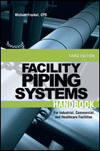Guest blog
The wonders of grooved piping
Increasingly popular option provides material and installation savings.


|
Although grooved fittings originated during World War I for rapid deployment of fuel and water lines to allied forces, grooved piping systems have become the fourth conventional piping method along with threaded, welded and flanged.
The rapid growth of grooved piping systems for low-pressure applications in the past 20 years has been stimulated by the cost savings of using thinner wall (lower-cost) pipe and the considerable lower installation costs. In addition to the most popular steel piping applications, the rapid growth of stainless piping has been met with development of stainless grooved pipe fittings to take advantage of the much lower cost of Schedule 5S and Schedule 10S stainless pipe. Similarly, there has been development of grooved copper pipe fittings but for a much smaller market.
In addition to the material cost savings, the installation of a grooved piping system is up to three times faster than welding, making it easier and more reliable than threading and flanging. This results in a lower installed cost.
The relatively inexpensive equipment for forming of both rolled grooves and cut grooves is less expensive than threading and can be performed by in-house maintenance personnel. This facilitates the making of changes and additions by in-house maintenance staff because each fitting has the characteristics of a union. This feature makes it possible to break into the line at any point without affecting the rest of the system.
Grooved fittings are not just for temporary lines in the construction industry and movable lines in irrigation systems. Lower-pressure lightweight grooved fittings and couplings now are used for routine required efficient dismantling and reconnecting for servicing and cleanout in many process industries.
Grooved piping systems are particularly popular in fire sprinkler systems, a constant market where fire protection is required for most new buildings and in upgrades for older buildings.
Most grooved fittings are cast in ductile iron (ASTM A-536, Grade 65-45-12), which is twice as strong as cast iron. The technical advances in precision casting produce grooved fitting castings and grooved couplings that meet groove dimensions and do not require machining, thereby reducing the costs of all components except gaskets. Since the gasket is the only joint part touching the internal media, standard couplings can be used with gaskets to meet the service requirements, including ethylene propylene diene monomer (EPDM), fluoroelastomers and nitrile.
Grooved-end piping systems are used in plumbing, fire protection, HVAC, municipal water and wastewater, industrial and OEM applications, potable water and corrosive services. They can be found in oilfield, chemical, food and beverage, power, cogeneration, mining process, military, shipbuilding and irrigation industries, while oil shale drilling for handling large amounts of wastewater is a new application.
Note: With the growth of grooved piping, many valve manufacturers are producing most types of valves with grooved ends, particularly butterfly valves in both manual and actuated operation.
Helpful Links:
Looking for a reprint of this article?
From high-res PDFs to custom plaques, order your copy today!







